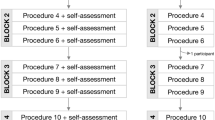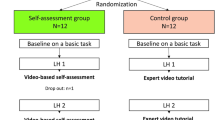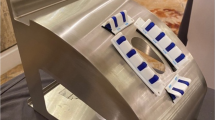Abstract
Purpose
Temporal bone surgery requires excellent surgical skills and simulation-based training can aid novices’ skills acquisition. However, simulation-based training is challenged by early stagnation of performance after few performances. Structured self-assessment during practice might enhance learning by inducing reflection and engagement in the learning task. In this study, structured self-assessment was introduced during virtual reality (VR) simulation of mastoidectomy to investigate the effects on subsequent performance during cadaveric dissection.
Methods
A prospective educational study with comparison with historical controls (reference cohort). At a temporal bone dissection course, eighteen participants performed structured self-assessment during 3 h of VR simulation mastoidectomy training before proceeding to cadaver dissection (intervention cohort). At a previous course, eighteen participants received identical VR simulation training but without the structured self-assessment (reference cohort). Final products from VR simulation and cadaveric dissection were recorded and assessed by two blinded raters using a 19-point modified Welling Scale.
Results
The intervention cohort completed fewer procedures (average 4.2) during VR simulation training than the reference cohort (average 5.7). Nevertheless, the intervention cohort achieved a significantly higher average performance score both in VR simulation (11.1 points, 95% CI [10.6–11.5]) and subsequent cadaveric dissection (11.8 points, 95% CI [10.7–12.8]) compared with the reference cohort, who scored 9.1 points (95% CI [8.7–9.5]) during VR simulation and 5.8 points (95% CI [4.8–6.8]) during cadaveric dissection.
Conclusions
Structured self-assessment is a valuable learning support during self-directed VR simulation training of mastoidectomy and the positive effect on performance transfers to subsequent cadaveric dissection performance.


Similar content being viewed by others
References
Frithioff A, Sørensen MS, Andersen SAW (2018) European status on temporal bone training: a questionnaire study. Eur Arch Otorhinolaryngol 275:357–363
Andersen SAW, Konge L, Cayé-Thomasen P, Sørensen MS (2015) Learning curves of virtual mastoidectomy in distributed and massed practice. JAMA Otolaryngol Head Neck Surg 141:913–918
Andersen SAW, Foghsgaard S, Cayé-Thomasen P, Sørensen MS (2018) The effect of a distributed virtual reality simulation training program on dissection mastoidectomy performance. Otol Neurotol 39:1277–1284
Cook DA, Hatala R, Brydges R, Zendejas B, Szostek JH, Wang AT et al (2011) Technology-enhanced simulation for health professions education: a systematic review and meta-analysis. JAMA 306:978–988
Lui JT, Hoy MY (2017) Evaluating the effect of virtual reality temporal bone simulation on mastoidectomy performance: a meta-analysis. Otolaryngol Head Neck Surg 156:1018–1024
Frithioff A, Frendø M, Weiss K, Foghsgaard S, Pedersen DB, Sørensen MS et al (2021) Effect of 3D-printed models on cadaveric dissection in temporal bone training. OTO Open 5:2473974X211065012
Frendø M, Konge L, Cayé-Thomasen P, Sørensen MS, Andersen SAW (2020) Decentralized Virtual Reality Training of Mastoidectomy Improves Cadaver Dissection Performance: A Prospective, Controlled Cohort Study. Otol Neurotol 41:476–81
Nash R, Sykes R, Majithia A, Arora A, Singh A, Khemani S (2012) Objective assessment of learning curves for the Voxel-Man TempoSurg temporal bone surgery computer simulator. J Laryngol Otol 126:663–669
Brydges R, Nair P, Ma I, Shanks D, Hatala R (2012) Directed self-regulated learning versus instructor-regulated learning in simulation training. Med Educ 46:648–656
Padgett J, Cristancho S, Lingard L, Cherry R, Haji F (2019) Engagement: what is it good for? The role of learner engagement in healthcare simulation contexts. Adv Health Sci Educ Theory Pract 24:811–825
Andersen SAW, Guldager M, Mikkelsen PT, Sørensen MS (2019) The effect of structured self-assessment in virtual reality simulation training of mastoidectomy. Eur Arch Otorhinolaryngol 276:3345–52
Andersen SAW, Frendø M, Guldager M, Sørensen MS (2020) Understanding the effects of structured self-assessment in directed, self-regulated simulation-based training of mastoidectomy: A mixed methods study. J Otol 15:117–23
Sorensen MS, Mosegaard J, Trier P (2009) The visible ear simulator: a public PC application for GPU-accelerated haptic 3D simulation of ear surgery based on the visible ear data. Otol Neurotol 30:484–487
Sieber DM, Andersen SAW, Sørensen MS, Mikkelsen PT (2021) OpenEar image data enables case variation in high fidelity virtual reality ear surgery. Otol Neurotol 42:1245–1252
The Visible Ear Simulator. http://ves.alexandra.dk. Accessed 15 Mar 2022.
Andersen SAW, Cayé-Thomasen P, Sørensen MS (2015) Mastoidectomy performance assessment of virtual simulation training using final-product analysis. Laryngoscope 125:431–435
Dunning D, Heath C, Suls JM (2004) Flawed self-assessment: implications for health, education, and the workplace. Psychol Sci Public Interest 5:69–106
Ericsson KA (2004) Deliberate practice and the acquisition and maintenance of expert performance in medicine and related domains. Acad Med 79:S70-81
Fitts PM, Posner MI (1967) Human performance. Oxford, England: Brooks/Cole
Andersen SAW, Konge L, Mikkelsen PT, Cayé-Thomasen P, Sørensen MS (2017) Mapping the plateau of novices in virtual reality simulation training of mastoidectomy. Laryngoscope 127:907–914
Looyestyn J, Kernot J, Boshoff K, Ryan J, Edney S, Maher C (2017) Does gamification increase engagement with online programs? A systematic review. PLoS ONE 12:e0173403
van Gaalen AEJ, Brouwer J, Schönrock-Adema J, Bouwkamp-Timmer T, Jaarsma ADC, Georgiadis JR (2021) Gamification of health professions education: a systematic review. Adv Health Sci Educ Theory Pract 26(2):683–711
Westenhaver ZK, Africa RE, Zimmerer RE, McKinnon BJ (2022) Gamification in otolaryngology: A narrative review. Laryngoscope Investig Otolaryngol 7:291–8.
Frithioff A, Frendø M, von Buchwald JH, Trier Mikkelsen P, Sørensen MS, Andersen SAW (2022) Automated summative feedback improves performance and retention in simulation training of mastoidectomy: a randomised controlled trial. J Laryngol Otol 136:29–36
Andersen SAW, Park YS, Sørensen MS, Konge L (2020) Reliable Assessment of Surgical Technical Skills Is Dependent on Context: An Exploration of Different Variables Using Generalizability Theory. Acad Med 95:1929–36
Frithioff A, Frendø M, Pedersen DB, Sørensen MS, Wuyts Andersen SA (2021) 3D-Printed Models for Temporal Bone Surgical Training: A Systematic Review. Otolaryngol Head Neck Surg 165:617–25
Chien WW, da Cruz MJ, Francis HW (2021) Validation of a 3D-printed human temporal bone model for otology surgical skill training. World J Otorhinolaryngol Head Neck Surg 7(2):88–93
Da Cruz MJ, Francis HW (2015) Face and content validation of a novel three-dimensional printed temporal bone for surgical skills development. J Laryngol Otol 129(Suppl 3):S23–9
Acknowledgements
We would like to thank Peter Trier Mikkelsen, MSc, from the Alexandra Institute who has programmed the Visible Ear Simulator.
Funding
None.
Author information
Authors and Affiliations
Corresponding author
Ethics declarations
Conflict of interests
The authors declare that they do not have any competing interests.
Additional information
Publisher's Note
Springer Nature remains neutral with regard to jurisdictional claims in published maps and institutional affiliations.
Rights and permissions
About this article
Cite this article
Andersen, S.A.W., Frithioff, A., von Buchwald, J.H. et al. Am I doing this right? Structured self-assessment during simulation training of mastoidectomy improves cadaver dissection performance: a prospective educational study. Eur Arch Otorhinolaryngol 280, 97–103 (2023). https://doi.org/10.1007/s00405-022-07454-z
Received:
Accepted:
Published:
Issue Date:
DOI: https://doi.org/10.1007/s00405-022-07454-z




